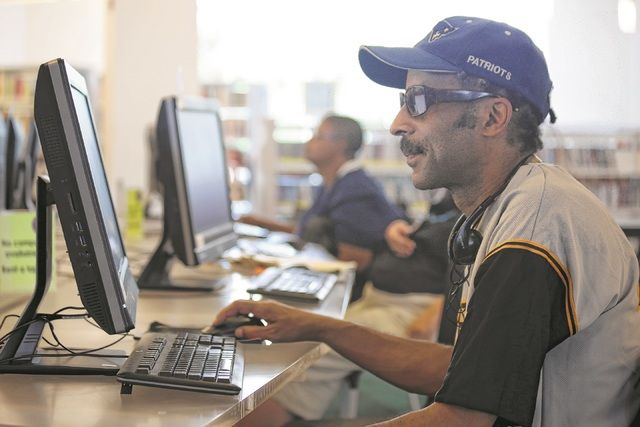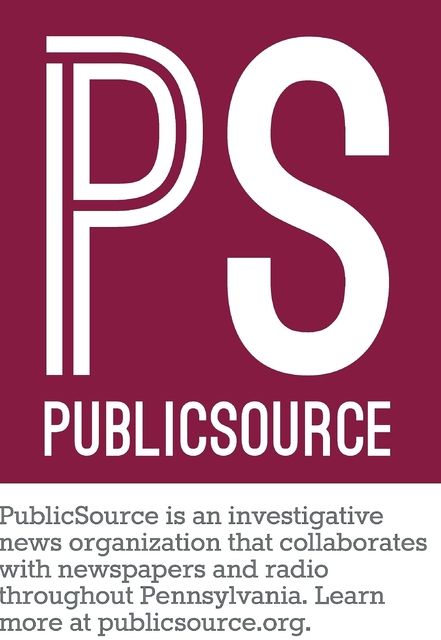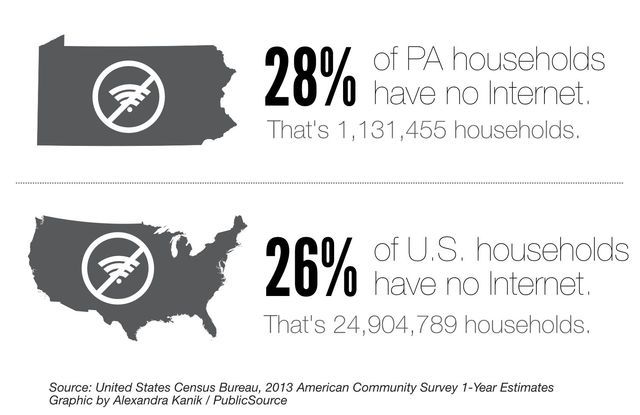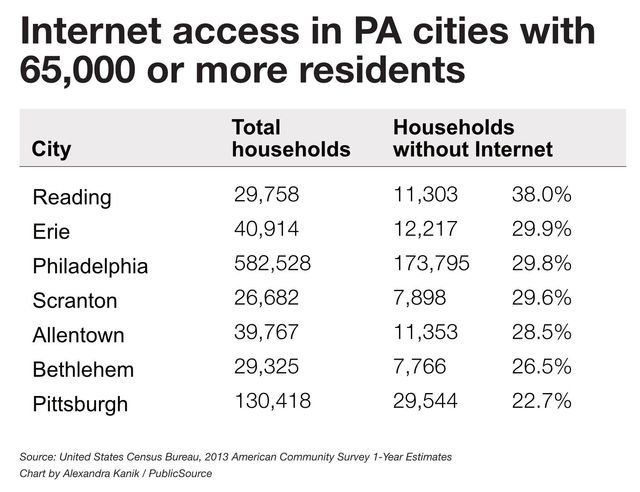Click here to subscribe today or Login.
President Barack Obama called the Internet “one of the most significant democratizing influences the world has ever known.” However, for many Americans, like Tracy Emerson of West Philadelphia, full connectivity remains out of reach.
Emerson is a 47-year-old single mother of two who canceled her home Internet service when she lost her job at a daycare center.
“I couldn’t afford it. They are always changing their packages,” said Emerson who had a bundle, “and it’s never less; it’s always more.”
Emerson has since relied on her smartphone for an Internet connection, but she and her teenage daughter had to find other options to complete schoolwork.
“Even if I go to the Laundromat, I bring my computer so I can do my homework,” said Emerson, who is working on a bachelor’s degree in healthcare administration.
At least 55 million Americans like Emerson lack reliable broadband Internet access at home — an issue that has swiftly moved from a nuisance to an impediment. In Pennsylvania, nearly one quarter of households lack Internet entirely, according to 2013 Census data.
The Pew Research Center found that disconnected Americans were more likely to be in lower income brackets and in rural areas.
Access to information on jobs, housing, educational resources, affordable health care and camaraderie, all increasingly found online, elude those without funds to pay for access as Internet costs rise and competitive pricing stagnates.
Emerson’s 20-year-old son needs the Internet to apply for jobs; her daughter, a rising high-school junior, has to fill out online college applications.
“She’ll usually stay after school to do it,” said Emerson, “and that means she’s coming home later and it’s dangerous.”
Her family has tried to use the public libraries in Philadelphia, but Emerson said library hours and time limits are inopportune. “I think Internet should be free for everybody because it’s so needed,” she said, suggesting a tax-based system that would be open to the public.
‘Stop and let that sink in’
Emerson’s dream of public Internet may be just that.
Not only is it expensive to create municipal networks, but in Pennsylvania and 18 other states, there are limitations on municipal broadband. Pennsylvania law requires current phone service providers such as Verizon to be offered the chance of providing the desired Internet service before the community is allowed to step in.
Big cities tend to stay out of the Internet business, leaving the giants to set the prices. To meet the Federal Communications Commission [FCC] Internet speed standard in Pittsburgh, it’s at least $44.99 monthly plus tax and equipment charges, rising after the first two years of service.
For $25 a month, Pittsburgh-area residents can hook up to DSL, which is far below the speed benchmark set by the Federal Communications Commission. However, once incumbent phone companies deploy fiber optic service in a given area, they may retire copper phone wires, eliminating cheaper DSL options.
Meanwhile, companies that provide faster service seem to split up the Internet landscape, according to a Center for Public Integrity analysis. Customers have fewer choices and must either pay what the one or two companies require or go without.
“Stop and let that sink in … three-quarters of American homes have no competitive choice for the essential infrastructure for 21st-century economics and democracy,” said FCC Chairman Tom Wheeler in a 2014 address. “Included in that is almost 20 percent who have no service at all!”
Nationally, more than 95 percent of surveyed households with incomes of $150,000 or more had Internet access in 2013, while only 48 percent of those making less than $25,000 had service at home, according to Census data.
In Philadelphia, the headquarters of the country’s largest home Internet service provider, the Comcast Corporation, about 173,800 households are without service, according to 2013 Census estimates.
Philadelphia, along with Pittsburgh, Erie and Allentown, were among the least-connected cities in the nation with 100,000 or more residents. Between 70 to 77 percent of households in those cities had Internet access.
In Pittsburgh, more people are turning to public libraries for Wi-Fi than ever before.
Wi-Fi use throughout Pittsburgh’s Carnegie Library system increased 19 percent between 2013 and 2014, with Wi-Fi sessions surpassing library computer use for the first time, according to the library’s annual report.
It’s made available for people like Point Park University student Dana Missouri, 48, who visited the East Liberty library branch one June day just so she could send an email to her professor.
“I wish I had the Internet at home,” said Missouri, a criminal justice major who canceled her service when she lost her nonprofit job. “When I got laid off, I had to downsize everything.”
As an exception, Lancaster is taking the digital divide into its own hands.
The city plans to offer free Wi-Fi in parks and to provide low-income residents with free or low-cost Internet in conjunction with the installation of a smart water metering system over the next year.
Charlotte Katzenmoyer, the city’s director of Public Works, said laying fiber was the most cost-effective way to install the metering system and that it made sense to use it for Internet service as well.
The laying of the fiber is budgeted at $500,000, an expense the city has built into the water bill and is expected to be further offset by leak prevention and eliminating the $100,000 Wi-Fi service for police and emergency services.
As required by law, the city of 60,000 first asked Verizon to provide the service, which it declined.
“We have a high poverty level in the city,” Katzenmoyer said, explaining the city’s motives to provide the service, “so there are many school district children who can’t afford to have Internet, yet many schools are requiring it.”
‘A human right’
While the FCC recognizes the Internet as crucial to 21st-century life, it has not acted on its authority to regulate Internet pricing.
But to offer some relief to low-income residents, the FCC proposed on June 18 to extend the government’s Lifeline telecommunications subsidy to allow participants to use the single $9.25 discount toward Internet or phone service. The discount is currently only applicable to phone service.
On July 15, President Barack Obama pledged to extend affordable or free home Internet access to public housing residents and low-income families in 27 cities, including Philadelphia, through a public-private partnership. The program, ConnectHome, will bring Internet access to more than 275,000 low-income households, according to a White House statement.
Comcast also has a program for low-income families who do not have home Internet. In order to be eligible for Comcast’s Internet Essentials, a child in the household must be eligible for free or reduced-price school lunch.
The $9.95-plus-tax monthly plan is aimed at connecting new low-income customers, but not everyone qualifies. Tracy Emerson said she doesn’t qualify because her family has a recent debt to Comcast.
“I have a bill that I am paying off because they were charging me for keeping their boxes,” she said, explaining she didn’t realize she had to arrange to return Comcast’s equipment.
Comcast Spokesman Charlie Douglas said the company forgives debts older than a year for the purpose of joining Internet Essentials. However, if families are current or recent customers, they can’t sign up even if they qualify.
Internet Essentials was “designed to crack that nut for families who have not signed up for the Internet,” he said.
In almost four years, the program has reached 17 percent of eligible users both nationwide and in Pennsylvania by the company’s estimates.
“Internet Essentials is a perfectly fine Internet program, but it’s not the same as encouraging competition in our market,” said Hannah Jane Sassaman, policy director of Philadelphia’s Media Mobilizing Project.
Sassaman helped organize the group’s CAP Comcast campaign to pressure the company to invest in the public good in light of the revenue and the tax abatements it’s received. The movement demands Comcast expand Internet Essentials to more low-income people, seniors, public-housing residents and people with disabilities.
“I think that the Internet is a human right,” Sassaman said.
Representatives from Comcast and Verizon were quick to point out that providing infrastructure for high speed Internet is costing billions. They also said service is faster now, so the price of the Internet per megabit has declined.
It would follow that once infrastructure investments decline, Internet prices should go down, but that hasn’t been the case. A study by Harvard scholar Susan Crawford and telecommunications analyst Mitchell Shapiro shows that while companies’ capital expenses have declined, they make more and more profit off of what exists.
Experts in the field surmise that cable Internet service providers have raised costs of standalone Internet to patch holes left by those who have canceled cable TV to save money.
Sharing the Internet
However, with rising costs come community-based solutions. Adam Longwill of Meta Mesh in Pittsburgh hopes to connect the disconnected through community bandwidth sharing.
The principle is that most people pay for more Internet than they use, Longwill explained. “People who are connected via [Internet service provider] donate unused bandwidth to those neighborhoods that might not otherwise have it,” he said.
His mesh network, currently installed in Pittsburgh’s Allentown neighborhood, expands Internet access from a cafe, for example, to the surrounding area. The more people who agree to share their networks through nodes installed on buildings, the larger area covered.
Meanwhile, those without nodes or Internet connections can just jump on the wireless network for a free ride. Another mesh network in Pittsburgh’s Shadyside neighborhood also provides free Wi-Fi access.
In an age where people often shy away from sharing Wi-Fi signals, concerned it will slow Internet speeds or lead to data breaches, Meta Mesh uses firewalls to offer a more secure solution for those who wish to share.
However, charging for the service to defray costs for donors would violate contracts such as Verizon’s that restrict reselling Internet or providing free public access.
Dani Teasley, 27, who lives in a boarding house in Pittsburgh, said she doesn’t have home Internet service because she can’t afford it on her own. “They won’t let us just pay for Wi-Fi and split it throughout the house,” Teasley said.
“I feel like I definitely miss out on job opportunities and opportunities to earn income. I used to support myself through freelance writing and editing, but it’s hard to do that without access to the Internet,” she said.









